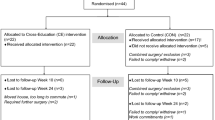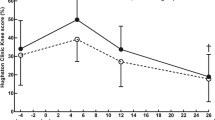Abstract
Purpose
The aim of this study was to investigate the effects of concentric and eccentric cross-education (CE) on quadriceps strength and knee function recoveries after anterior cruciate ligament (ACL) reconstruction.
Methods
Forty-eight patients (age: 29.5 ± 6.8 years, body mass index: 26.1 ± 3.2 kg/m2) who had undergone ACL reconstruction with hamstring tendon autograft were included in the study. The patients were randomly divided into three groups when they reached four weeks post surgery: (1) concentric CE (n = 16); (2) eccentric CE (n = 16); and (3) control (n = 16). All groups followed the same post-surgical rehabilitation program for their reconstructed limb. Additionally, the two experimental groups followed eight weeks of isokinetic training for the uninjured knee at 60°/s for 3 days per week. Quadriceps maximum voluntary isometric strength (MVIC) was measured during the 4th week (pre-training), 12th week (post training), and 24th week post surgery. The single-leg hop distance and International Knee Documentary Committee (IKDC) scores were also evaluated during the 24th week post surgery. Analysis of variance was used for statistical analysis.
Results
Group-by-time interaction was significant for quadriceps MVICs for reconstructed and healthy limbs (p = 0.02). Quadriceps strength of both knees was greater in concentric and eccentric CE groups compared to control group during the 12th- and 24th weeks post surgery (p < 0.05). Strength gain was 28% and 31% in concentric and eccentric CE groups, respectively, when compared with the control group. Concentric and eccentric CE had similar effects on quadriceps strength recovery (n.s.). IKDC score, and single-leg hop distances were not significantly different among groups (n.s.).
Conclusions
Concentric and eccentric quadricep strengthening of healthy limbs in early phases of ACL rehabilitation improved post-surgical quadriceps strength recovery of the reconstructed limb. CE should be integrated into ACL reconstruction rehabilitation, especially in the early rehabilitative phases to restore quadriceps strength.
Level of evidence
Randomized controlled trial, Level I.

Similar content being viewed by others
References
Ageberg E, Roos HP, Silbernagel KG, Thomee R, Roos EM (2009) Knee extension and flexion muscle power after anterior cruciate ligament reconstruction with patellar tendon graft or hamstring tendons graft: a cross-sectional comparison 3 years post surgery. Knee Surg Sports Traumatol Arthrosc 17:162–169
American College of Sports M (2009) American College of Sports Medicine position stand. Progression models in resistance training for healthy adults. Med Sci Sports Exerc 41:687–708
Augustsson J (2013) Documentation of strength training for research purposes after ACL reconstruction. Knee Surg Sports Traumatol Arthrosc 21:1849–1855
Beyer KS, Fukuda DH, Boone CH, Wells AJ, Townsend JR, Jajtner AR et al (2016) Short-term unilateral resistance training results in cross Education of strength without changes in muscle size, activation, or endocrine response. J Strength Cond Res 30:1213–1223
Beynnon BD, Johnson RJ, Abate JA, Fleming BC, Nichols CE (2005) Treatment of anterior cruciate ligament injuries, part I. Am J Sports Med 33:1579–1602
Callaghan MJ, McCarthy CJ, Al-Omar A, Oldham JA (2000) The reproducibility of multi-joint isokinetic and isometric assessments in a healthy and patient population. Clin Biomech (Bristol Avon) 15:678–683
Carroll TJ, Herbert RD, Munn J, Lee M, Gandevia SC (2006) Contralateral effects of unilateral strength training: evidence and possible mechanisms. J Appl Physiol (1985) 101:1514–1522
Cirer-Sastre R, Beltran-Garrido JV, Corbi F (2017) Contralateral effects after unilateral strength training: a meta-analysis comparing training loads. J Sports Sci Med 16:180–186
Escamilla RF, Macleod TD, Wilk KE, Paulos L, Andrews JR (2012) Anterior cruciate ligament strain and tensile forces for weight-bearing and non-weight-bearing exercises: a guide to exercise selection. J Orthop Sports Phys Ther 42:208–220
Farthing JP, Borowsky R, Chilibeck PD, Binsted G, Sarty GE (2007) Neuro-physiological adaptations associated with cross-education of strength. Brain Topogr 20:77–88
Farthing JP, Krentz JR, Magnus CR, Barss TS, Lanovaz JL, Cummine J et al (2011) Changes in functional magnetic resonance imaging cortical activation with cross education to an immobilized limb. Med Sci Sports Exerc 43:1394–1405
Fimland MS, Helgerud J, Solstad GM, Iversen VM, Leivseth G, Hoff J (2009) Neural adaptations underlying cross-education after unilateral strength training. Eur J Appl Physiol 107:723–730
Gokeler A, Bisschop M, Benjaminse A, Myer GD, Eppinga P, Otten E (2014) Quadriceps function following ACL reconstruction and rehabilitation: implications for optimisation of current practices. Knee Surg Sports Traumatol Arthrosc 22:1163–1174
Hart JM, Pietrosimone B, Hertel J, Ingersoll CD (2010) Quadriceps activation following knee injuries: a systematic review. J Athl Train 45:87–97
Hortobagyi T, Lambert NJ, Hill JP (1997) Greater cross education following training with muscle lengthening than shortening. Med Sci Sports Exerc 29:107–112
Irrgang JJ, Anderson AF, Boland AL, Harner CD, Kurosaka M, Neyret P et al (2001) Development and validation of the international knee documentation committee subjective knee form. Am J Sports Med 29:600–613
Ithurburn MP, Paterno MV, Ford KR, Hewett TE, Schmitt LC (2015) Young athletes with quadriceps femoris strength asymmetry at return to sport after anterior cruciate ligament reconstruction demonstrate asymmetric single-leg drop-landing mechanics. Am J Sports Med 43:2727–2737
Kidgell DJ, Frazer AK, Daly RM, Rantalainen T, Ruotsalainen I, Ahtiainen J et al (2015) Increased cross-education of muscle strength and reduced corticospinal inhibition following eccentric strength training. Neuroscience 300:566–575
Kramer GA, DeMarais DR (1992) Reliability and validity of the pilot national board dental examination. J Dent Educ 56:236–241
Latella C, Kidgell DJ, Pearce AJ (2012) Reduction in corticospinal inhibition in the trained and untrained limb following unilateral leg strength training. Eur J Appl Physiol 112:3097–3107
Lee M, Carroll TJ (2007) Cross education: possible mechanisms for the contralateral effects of unilateral resistance training. Sports Med 37:1–14
Lepley LK, Palmieri-Smith RM (2014) Cross-education strength and activation after eccentric exercise. J Athl Train 49:582–589
Manca A, Dragone D, Dvir Z, Deriu F (2017) Cross-education of muscular strength following unilateral resistance training: a meta-analysis. Eur J Appl Physiol 117:2335–2354
Munn J, Herbert RD, Gandevia SC (2004) Contralateral effects of unilateral resistance training: a meta-analysis. J Appl Physiol (1985) 96:1861–1866
Munn J, Herbert RD, Hancock MJ, Gandevia SC (2005) Training with unilateral resistance exercise increases contralateral strength. J Appl Physiol (1985) 99:1880–1884
Papandreou M, Billis E, Papathanasiou G, Spyropoulos P, Papaioannou N (2013) Cross-exercise on quadriceps deficit after ACL reconstruction. J Knee Surg 26:51–58
Paterno MV, Schmitt LC, Ford KR, Rauh MJ, Myer GD, Huang B et al (2010) Biomechanical measures during landing and postural stability predict second anterior cruciate ligament injury after anterior cruciate ligament reconstruction and return to sport. Am J Sports Med 38:1968–1978
Pipes TV, Wilmore JH (1975) Isokinetic vs isotonic strength training in adult men. Med Sci Sports 7:262–274
Schmitt LC, Paterno MV, Ford KR, Myer GD, Hewett TE (2015) Strength asymmetry and landing mechanics at return to sport after anterior cruciate ligament reconstruction. Med Sci Sports Exerc 47:1426–1434
Schmitt LC, Paterno MV, Hewett TE (2012) The impact of quadriceps femoris strength asymmetry on functional performance at return to sport following anterior cruciate ligament reconstruction. J Orthop Sports Phys Ther 42:750–759
Scripture EWST, Brown EM (1894) On the education of muscular control and power. Stud Yale Psychol Lab 2:5
Shima N, Ishida K, Katayama K, Morotome Y, Sato Y, Miyamura M (2002) Cross education of muscular strength during unilateral resistance training and detraining. Eur J Appl Physiol 86:287–294
Thomas AC, Wojtys EM, Brandon C, Palmieri-Smith RM (2016) Muscle atrophy contributes to quadriceps weakness after anterior cruciate ligament reconstruction. J Sci Med Sport 19:7–11
Tourville TW, Jarrell KM, Naud S, Slauterbeck JR, Johnson RJ, Beynnon BD (2014) Relationship between isokinetic strength and tibiofemoral joint space width changes after anterior cruciate ligament reconstruction. Am J Sports Med 42:302–311
Weir JP, Housh DJ, Housh TJ, Weir LL (1997) The effect of unilateral concentric weight training and detraining on joint angle specificity, cross-training, and the bilateral deficit. J Orthop Sports Phys Ther 25:264–270
Weir JP, Housh DJ, Housh TJ, Weir LL (1995) The effect of unilateral eccentric weight training and detraining on joint angle specificity, cross-training, and the bilateral deficit. J Orthop Sports Phys Ther 22:207–215
Wilk KE, Romaniello WT, Soscia SM, Arrigo CA, Andrews JR (1994) The relationship between subjective knee scores, isokinetic testing, and functional testing in the ACL-reconstructed knee. J Orthop Sports Phys Ther 20:60–73
Zhou S (2000) Chronic neural adaptations to unilateral exercise: mechanisms of cross education. Exerc Sport Sci Rev 28:177–184
Funding
No external source of funding was used.
Author information
Authors and Affiliations
Corresponding author
Ethics declarations
Conflict of interest
The authors declare that they have no conflict of interest.
Ethical approval
This study was approved by Hacettepe University Institutional Review Board (KA/17157).
Informed consent
Informed consent was obtained from all individual participants included in the study.
Electronic supplementary material
Below is the link to the electronic supplementary material.
Rights and permissions
About this article
Cite this article
Harput, G., Ulusoy, B., Yildiz, T.I. et al. Cross-education improves quadriceps strength recovery after ACL reconstruction: a randomized controlled trial. Knee Surg Sports Traumatol Arthrosc 27, 68–75 (2019). https://doi.org/10.1007/s00167-018-5040-1
Received:
Accepted:
Published:
Issue Date:
DOI: https://doi.org/10.1007/s00167-018-5040-1




